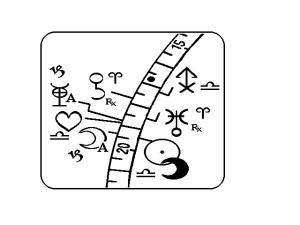When you undertake to use a whole bunch of asteroids in your charts and
understanding, you face a huge problem of information management. Maybe you
quivered when you first added the 8 transneptunians. Then you look at
however-many asteroids you're ready to incorporate, and your brain starts
calling you dirty names! That's why you want to learn about the use of
dials, especially 90 degree dials where you enter factors by Mode. Any
Cardinal factor is entered in the 00-29 degree segement regardless of sign.
Any Fixed factor is entered in the 30-59 part of the dial, and any Mutable
factor is entered in the 60-89 degree area.
As you see from this graphic, dials help you to accomplish the essential
business of recognizing aspects. Here, you are looking at the 17-19 degree
area of a dial where the Cardinal factors (angles, planets, TNPs and/or
asteroids) would be entered. As you study the graphic, you see the October
12th New Moon represented in 19 Libra. See Zeus in 17 Libra and notice
Uranus in 18 Aries. Also see the asteroids: Persephone in 17 Aries, Admete
in late 18 Capricorn, Valentine in 18 Libra and Memoria in 19 Capricorn.
Here's what to know: Just by the way factors (angles, planets, TNPs and
asteroids) are entered on a dial ORGANIZES THEM BY ASPECT. This is
essential if you are really serious about using a number of asteroids. Just
seeing this on a dial keys you to the potent T-square where the
Sun-Zeus-Valentine in Libra is opposed by the Uranus-Persephone in Aries
with the squares of Admete and Memoria in Capricorn.
Dial use also asks that you focus more on "the conversation" of factors than
on the signs. What you are tuning into is how the closely related factors
might affect or influence one another. You will want to "hear" the
argument among factors in aspect by focussing on how one's key concepts
might interact with another's. As you look at these energies, you see that
Admete can create a blockage for the (Valentine) heart. You are reminded
that heart disease can be a risk factor for (Memoria: memory issues)
dementia; you see concern for (Uranus-Valentine) heart valves; you see
attention to the (Zeus-Valentine) pulse and blood pressure. You see the
worry about a (Uranus) sudden event for the (Valentine) heart-- especially
where there might be (Admete) blockages or (Admete-Valentine) narrowed
arteries that (Uranus) disrupt the heart rhythm. You kjnow that a person
can have felt so (Uranus) different or like an outsider that they
(Persephone) never felt like they belonged, so they (Admete) avoided others
or felt isolated. You expect that in some manifestations, it will be a
person's (Uranus) unusual (Valentine) sexual orientation that will cause
them to (Persephone) feel alone and to (Admete) avoid or turn a cold
shoulder to others.
By entering a chart on a dial, you free yourself to dive into "the stories"
the energies are telling. This doesn't mean that you can't study the chart
in 360* format and use rulerships and such, it's just that, when you try to
look at the aspects, it can get overwhelming, and the dial solves that
problem for you.
It may take some getting used to, but it will enable you to incorporate lots
more factors into your charts (without having you lose your mind.)
I used to give a lecture titled, "Dials and Asteroids are Magic." I still
think that. Once you get used to seeing a chart on a dial, there are all
kinds of really cool things a dial does (without math.) There is the axis
of a point under study; there is its "Golden Triangle;" there are midpoints
and a full structure to it; and there are the events pointed out by solar
arc directions. Once you see a chart on a dial, a "working dial" (a
smaller, moveable dial) is placed on it to accomplish the work of midpoints,
differences and formulas WITHOUT MATH. While you might go to a conference
and see Uranian (dial) astrology presented as an especially difficult thing,
don't believe it!
For now, just imagine how cool it will be to not get a headache going around
a 360* chart trying to incorporate all those asteroid aspects!
--------
P.S. If you don't know about this, there is a site newsletter that you can
sign up for. It comes out irregularly but features asteroid issues and
ideas not covered here. It's free!
There is also a monthly print newsletter, "Tools of the Trade," that features delineation and both radix and predtive techniques. It is six pages with one of them being an advance ephemeris of 65 asteroids. In the US, a yearly subscription is $28.00. Contact me for a free review copy to see if it fits with your practice.

